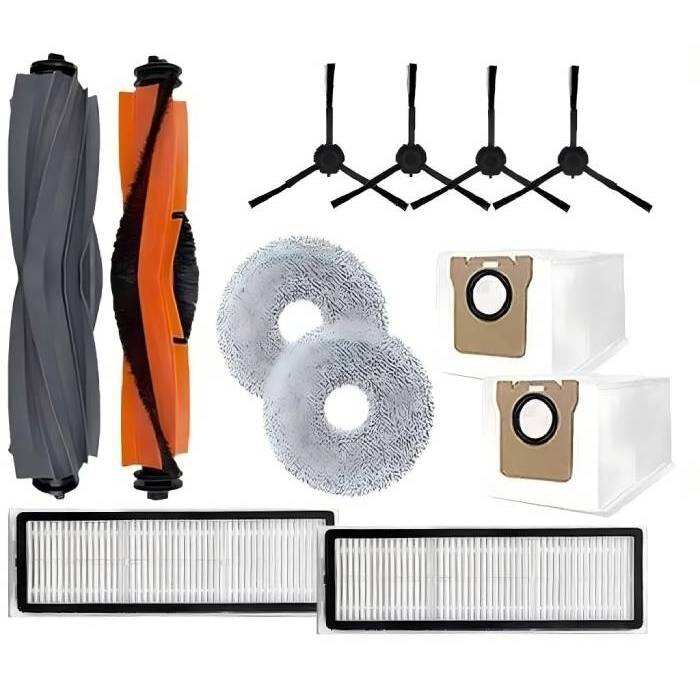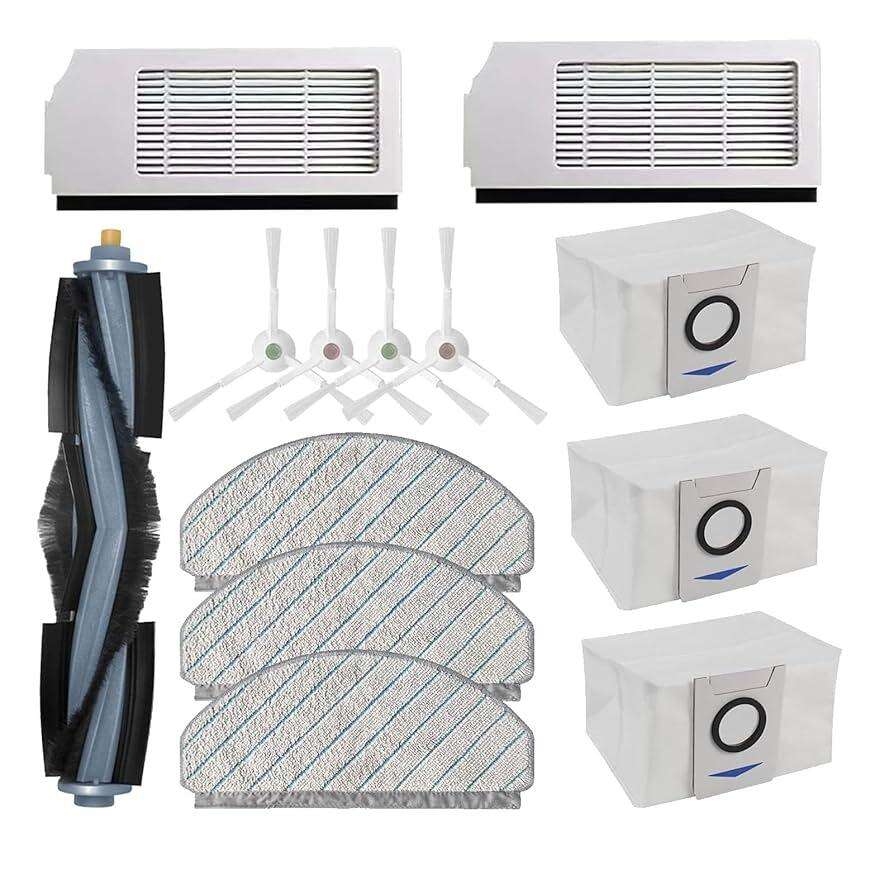The evolution of robotic cleaning technology has transformed commercial and residential cleaning operations across multiple sectors. Modern automated cleaning systems demand high-quality components that can withstand continuous operation while maintaining optimal performance standards. Understanding which applications require the most durable robot vacuum parts helps businesses and facilities managers make informed decisions about equipment investments and maintenance strategies.
Commercial Office Buildings and Corporate Environments
High-Traffic Areas and Daily Cleaning Cycles
Corporate office buildings represent one of the most demanding environments for robotic cleaning systems. These facilities typically operate cleaning cycles multiple times daily to maintain professional appearances and hygiene standards. The constant foot traffic, varying debris types, and extended operational hours place significant stress on essential components including motors, brushes, filters, and navigation sensors.
Premium office complexes often require specialized robot vacuum parts designed for extended duty cycles. Components must resist wear from carpet fibers, paper particles, food crumbs, and other common office debris. The filtration systems in these environments face particular challenges from dust accumulation and air quality requirements that exceed standard residential specifications.
Lobby Areas and Reception Spaces
Reception areas and main lobbies experience the highest traffic volumes in commercial buildings, creating unique challenges for robotic cleaning equipment. These spaces often feature mixed flooring materials including marble, tile, and carpet transitions that require adaptable cleaning mechanisms. The frequent presence of visitors and staff during business hours necessitates quiet operation modes and sophisticated obstacle detection capabilities.
Maintenance teams in corporate environments typically prefer modular component designs that allow quick replacement during off-hours. The ability to swap out worn brushes, empty collection bins, and replace filters without extensive downtime becomes critical for maintaining consistent cleaning schedules and professional facility appearances.
Healthcare Facilities and Medical Centers
Sterile Environment Requirements
Healthcare facilities impose the most stringent requirements on robotic cleaning systems due to infection control protocols and patient safety considerations. Hospital-grade robot vacuum parts must meet medical device standards and withstand frequent sanitization procedures using chemical disinfectants.
The sensitive nature of medical environments requires components that operate silently during patient care hours while maintaining exceptional filtration efficiency. HEPA-grade filters and sealed component housings prevent cross-contamination between patient rooms and clinical areas. Regular replacement schedules become critical for maintaining sterile conditions and preventing equipment-related infection risks.
Emergency Departments and Intensive Care Units
Critical care areas present unique challenges for robotic cleaning systems due to the presence of medical equipment, emergency procedures, and round-the-clock operations. Components must demonstrate exceptional reliability since cleaning interruptions could compromise patient care protocols. The harsh cleaning chemicals used in these environments accelerate component degradation, requiring more frequent replacement cycles.
Navigation systems in healthcare settings must accommodate constantly changing layouts due to mobile medical equipment and patient transfers. Advanced sensor arrays and adaptive programming capabilities become essential for maintaining effective cleaning patterns while avoiding interference with critical medical devices and emergency responses.
Educational Institutions and Schools
Classroom and Corridor Maintenance
Educational facilities create challenging environments for robotic cleaning systems due to high student populations, varied debris types, and limited maintenance windows. School corridors experience intense foot traffic during class changes, while classrooms accumulate diverse materials including paper scraps, food particles, and craft supplies that require versatile cleaning capabilities.
The durability requirements for components in educational settings focus on impact resistance and debris handling capacity. Student activities often result in larger particles and occasional liquid spills that can damage sensitive electronic components. Robust housing designs and sealed electrical connections help protect critical systems from accidental damage during daily operations.

Cafeterias and Multi-Purpose Areas
School dining areas and gymnasiums present complex cleaning challenges that demand specialized component configurations. These spaces typically feature large open areas with mixed flooring materials and high debris volumes during meal periods and events. The cleaning systems must handle everything from food particles to sporting equipment residue while maintaining consistent performance across different surface types.
Component durability in these environments focuses on brush systems capable of handling sticky substances and wet debris without clogging or motor damage. Enhanced suction capabilities and reinforced collection systems help manage the higher debris volumes common in multi-purpose educational spaces.
Retail Stores and Shopping Centers
Customer-Facing Areas During Operating Hours
Retail environments require robotic cleaning systems that can operate discreetly during business hours while maintaining store presentation standards. Components must demonstrate exceptional reliability since cleaning interruptions directly impact customer experience and sales operations. The constant presence of shoppers necessitates advanced obstacle detection and quiet operation capabilities.
The variety of debris encountered in retail settings ranges from packaging materials to food court waste, requiring versatile component designs. Seasonal variations in debris types, such as tracked-in snow or leaves, create additional durability requirements for brush systems and filtration components that must adapt to changing environmental conditions.
Back-of-House and Storage Areas
Warehouse and storage areas within retail facilities often experience the most demanding cleaning conditions due to cardboard dust, packaging materials, and heavy foot traffic from staff operations. These spaces typically allow for more intensive cleaning cycles during off-hours, placing sustained stress on motor systems and mechanical components.
The industrial nature of back-of-house operations requires components designed for continuous duty cycles and resistance to abrasive materials. Reinforced brush assemblies and enhanced filtration systems help manage the higher debris loads while maintaining consistent cleaning performance throughout extended operational periods.
Manufacturing and Industrial Facilities
Production Floor Maintenance
Manufacturing environments create some of the most challenging conditions for robotic cleaning systems due to industrial debris, chemical exposure, and contamination control requirements. Components must withstand exposure to metal shavings, chemical residues, and temperature variations while maintaining precise navigation capabilities around complex machinery layouts.
The specialized nature of industrial cleaning requires robust component designs that can handle abrasive materials without compromising performance or creating safety hazards. Sealed bearing assemblies and corrosion-resistant materials become essential for maintaining operational reliability in harsh industrial environments.
Clean Room and Controlled Environment Applications
Semiconductor facilities and pharmaceutical manufacturing areas impose extreme requirements on robotic cleaning systems due to contamination control protocols and precision manufacturing needs. Components must meet strict particle emission standards while maintaining exceptional cleaning efficiency in controlled atmosphere conditions.
The ultra-clean requirements of these environments necessitate specialized filtration systems and sealed component assemblies that prevent any particle release during operation. Regular validation and replacement schedules become critical for maintaining compliance with industrial standards and preventing costly production contamination events.
FAQ
How often should robot vacuum parts be replaced in commercial applications
Replacement frequency for robot vacuum parts in commercial settings depends on usage intensity and environmental conditions. High-traffic areas typically require brush replacements every 2-3 months, while filters may need monthly replacement. Motors and electronic components generally last 12-18 months under normal commercial use, though harsh environments may reduce this timeline significantly.
What are the most critical components for durability in industrial cleaning applications
In industrial environments, motor assemblies and brush systems experience the greatest stress and require the most durable construction. Sealed bearing systems, corrosion-resistant materials, and reinforced housing designs are essential for withstanding abrasive debris and chemical exposure. Navigation sensors also need ruggedized protection to maintain accuracy in challenging industrial conditions.
How do healthcare facility requirements differ from standard commercial cleaning needs
Healthcare applications require components that can withstand frequent chemical sanitization while maintaining sterile operation standards. All components must be compatible with hospital-grade disinfectants and feature sealed designs that prevent bacterial growth. Additionally, noise levels must remain extremely low to avoid disrupting patient care, requiring specialized motor and fan designs.
Which environmental factors most impact component longevity in robotic cleaning systems
Temperature extremes, humidity levels, and debris composition significantly impact component lifespan. Abrasive materials like sand or metal particles accelerate wear on brush systems and internal mechanisms. Chemical exposure from cleaning agents or industrial processes can degrade seals and electronic components, while high humidity environments may cause corrosion in metal parts and electrical connections.
Table of Contents
- Commercial Office Buildings and Corporate Environments
- Healthcare Facilities and Medical Centers
- Educational Institutions and Schools
- Retail Stores and Shopping Centers
- Manufacturing and Industrial Facilities
-
FAQ
- How often should robot vacuum parts be replaced in commercial applications
- What are the most critical components for durability in industrial cleaning applications
- How do healthcare facility requirements differ from standard commercial cleaning needs
- Which environmental factors most impact component longevity in robotic cleaning systems

